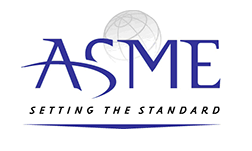Featured Partners - ASME
SBB is made possible by the contributions, support, and active participation of its Partner organizations. The American Society of Mechanical Engineers (ASME) has been an SBB Partner since 2010.

Scope
Founded in 1880 as the American Society of Mechanical Engineers, ASME is a not-for-profit scientific, educational, and technical organization for mechanical
engineers and other technical professionals whose mission is to serve diverse global communities by advancing, disseminating, and applying engineering knowledge for
improving quality of life. ASME serves several important functions, one of which is the development and maintenance of over 500 voluntary consensus standards
which are used in over 100 countries around the world. These include standards for power plant systems and components; piping and pipelines; elevators and escalators; and items as
ubiquitous as nuts, bolts, and plumbing fixtures.
These standards reduce the costs of goods and services; enhance safety, health, and quality of life; and facilitate innovation, trade, and competitiveness while
substantially reducing costs by providing a consistent, commercially relevant, and technically sound basis for the design, construction, inspection, testing, operation,
maintenance, and repair of engineered components and systems.
ASME also provides conformity assessment services to over 6,500 manufacturers in 75 countries in areas such as boiler, pressure vessel, bioprocessing, and nuclear
power component certification, and has numerous personnel training and
certification programs.
In order to maximize the relevancy of its standards for the benefit of its numerous stakeholders, ASME strives to foster an open and inclusive standards development process.
Membership on all ASME standards development committees is free and open to all technically qualified individuals with a willingness and ability to participate, and all of
its standards development committee meetings are free and open to the public.
Learn more about participating in ASME standards activities.
Standard/Conformance Tools
Like the industries and businesses it serves, ASME’s standards portfolio is continuously changing to address the latest in technology and reflect evolving commercial practices. Whether a business would like to incorporate a new material for use in a pressure technology application, better understand potential cost savings from energy systems, validate complex models prior to prototyping, consistently communicate design intent on engineering drawings, ensure the qualifications of its employees, or aggregate data to help commercialize new technology, ASME’s standards can be useful tools for maximizing the efficient deployment of resources to ensure sustainable competitiveness.
Below is just a sampling of ASME’s standards and conformity assessment resources.
To learn more about ASME’s standards and conformity assessment activities, visit their Who We Are webpage or the ASME online product catalog.
Industry Sectors Served
Energy and power, oil and gas, manufacturing, engineering, aerospace and defense, automotive, building/construction and infrastructure, chemical/petrochemical
Contact
American Society of Mechanical Engineers (ASME)
Two Park Avenue
New York, NY 10016-5990
Web: www.asme.org
E-mail: CustomerCare@asme.org
Phone: 212-591-8520
Fax: 973-882-1717